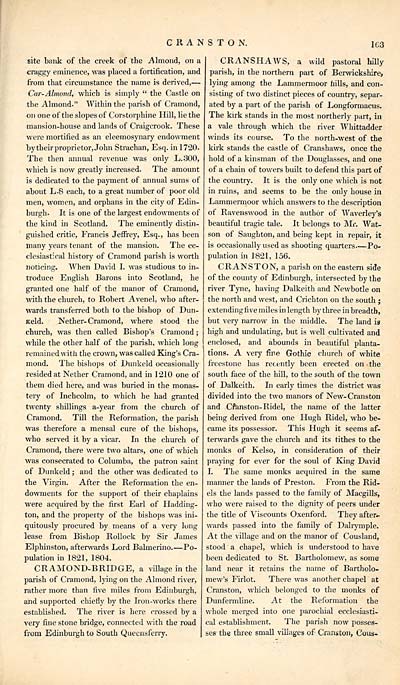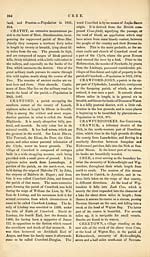Gazetteer of Scotland > Volume 1
(191) Page 163
Download files
Complete book:
Individual page:
Thumbnail gallery: Grid view | List view

CRANSTON.
IC3
site bank of the creek of the -Almond, on a
craggy eminence, was placed a fortification, and
from that circumstance the name is derived, —
Car-Almond, which is simply " the Castle on
the Almond." Within the parish of Cramond,
on one of the slopes of Corstorphine Hill, lie the
mansion-house and lands of Craigcrook. These
were mortified as an eleemosynary endowment
bytheirproprietor,John Strachan, Esq. in 1720.
The then annual revenue was only L.300,
which is now greatly increased. The amount
is dedicated to the payment of annual sums of
about L-8 each, to a great number of poor old
men, women, and orphans in the city of Edin-
burgh. It is one of the largest endowments of
the kind in Scotland. The eminently distin-
guished critic, Francis Jeffrey, Esq., has been
many years tenant of the mansion. The ec-
clesiastical history of Cramond parish is worth
noticing. When David I. was studious to in-
troduce English Barons into Scotland, he
granted one half of the manor of Cramond,
with the church, to Robert Avenel, who after-
wards transferred both to the bishop of Dun-
Keld. Nether- Cramond, where stood the
church, was then called Bishop's Cramond ;
while the other half of the parish, which long
remained with the crown, was called King's Cra-
mond. The bishops of Dunkeld occasionally
resided at Nether Cramond, and in 1210 one of
them died here, and was buried in the monas-
tery of Inchcolm, to which he had granted
twenty shillings a-year from the church of
Cramond. Till the Reformation, the parish
was therefore a mensal cure of the bishops,
who served it by a vicar. In the church of
Cramond, there were two altars, one of which
was consecrated to Columba, the patron saint
of Dunkeld ; and the other was dedicated to
the Virgin. After the Reformation the en-
dowments for the support of their chaplains
were acquired by the first Earl of Hadding-
ton, and the property of the bishops was ini-
quitously procured by means of a very long
lease from Bishop Rollock by Sir James
Elphinston, afterwards Lord Balmerino. — Po-
pulation in 1821, 1804.
CRAMOND-BRIDGE, a village in the
parish of Cramond, lying on the Almond river,
rather more than five miles from Edinburgh,
and supported chiefly by the Iron-works there
established. The river is here crossed by a
very fine stone bridge, connected with the road
from Edinburgh to South Queensferry.
CRANSHAWS, a wild pastoral hilly
parish, in the northern part of Berwickshire,
lying among the Lammermoor hills, and con-
sisting of two distinct pieces of country, separ-
ated by a part of the parish of Longformacus.
The kirk stands in the most northerly part, in
a vale through which the river Whittadder
winds its course. To the north-west of the
kirk stands the castle of Cranshaws, once the
hold of a kinsman of the Douglasses, and one
of a chain of towers built to defend this part of
the country. It is the only one which is not
in ruins, and seems to be the only house in
Lammermoor which answers to the description
of Ravenswood in the author of Waverley's
beautiful tragic tale. It belongs to Mr. Wat-
son of Saughton, and being kept in repair, it
is occasionally used as shooting quarters Po-
pulation in 1821, 156.
CRANSTON, a parish on the eastern side
of the county of Edinburgh, intersected by the
river Tyne, having Dalkeith and Newbotle on
the north and west, and Crichton on the south ;
extendingfive miles in length by three in breadth,
but very narrow in the middle. The land is
high and undulating, but is well cultivated and
enclosed, and abounds in beautiful planta-
tions. A very fine Gothic church of white
freestone has recently been erected on the
south face of the hill, to the south of the town
of Dalkeith. In early times the district was
divided into the two manors of New- Cranston
and Cfanston- Ridel, the name of the latter
being derived from one Hugh Ridel, who be-
came its possessor. This Hugh it seems af-
terwards gave the church and its tithes to the
monks of Kelso, in consideration of their
praying for ever for the soul of King David
I. The same monks acquired in the same
manner the lands of Preston. From the Rid-
els the lands passed to the family of Macgills,
who were raised to the dignity of peers under
the title of Viscounts Oxenford. They after-
wards passed into the family of Dalrymple.
At the village and on the manor of Cousland,
stood a chapel, which is understood to have
been dedicated to St. Bartholomew, as some
land near it retains the name of Bartholo-
mew's Firlot. There was another chapel at
Cranston, which belonged to the monks of
Dunfermline. At the Reformation the
whole merged into one parochial ecclesiasti-
cal establishment. The parish now posses-
ses the three small villages of Cranston, Cous-
IC3
site bank of the creek of the -Almond, on a
craggy eminence, was placed a fortification, and
from that circumstance the name is derived, —
Car-Almond, which is simply " the Castle on
the Almond." Within the parish of Cramond,
on one of the slopes of Corstorphine Hill, lie the
mansion-house and lands of Craigcrook. These
were mortified as an eleemosynary endowment
bytheirproprietor,John Strachan, Esq. in 1720.
The then annual revenue was only L.300,
which is now greatly increased. The amount
is dedicated to the payment of annual sums of
about L-8 each, to a great number of poor old
men, women, and orphans in the city of Edin-
burgh. It is one of the largest endowments of
the kind in Scotland. The eminently distin-
guished critic, Francis Jeffrey, Esq., has been
many years tenant of the mansion. The ec-
clesiastical history of Cramond parish is worth
noticing. When David I. was studious to in-
troduce English Barons into Scotland, he
granted one half of the manor of Cramond,
with the church, to Robert Avenel, who after-
wards transferred both to the bishop of Dun-
Keld. Nether- Cramond, where stood the
church, was then called Bishop's Cramond ;
while the other half of the parish, which long
remained with the crown, was called King's Cra-
mond. The bishops of Dunkeld occasionally
resided at Nether Cramond, and in 1210 one of
them died here, and was buried in the monas-
tery of Inchcolm, to which he had granted
twenty shillings a-year from the church of
Cramond. Till the Reformation, the parish
was therefore a mensal cure of the bishops,
who served it by a vicar. In the church of
Cramond, there were two altars, one of which
was consecrated to Columba, the patron saint
of Dunkeld ; and the other was dedicated to
the Virgin. After the Reformation the en-
dowments for the support of their chaplains
were acquired by the first Earl of Hadding-
ton, and the property of the bishops was ini-
quitously procured by means of a very long
lease from Bishop Rollock by Sir James
Elphinston, afterwards Lord Balmerino. — Po-
pulation in 1821, 1804.
CRAMOND-BRIDGE, a village in the
parish of Cramond, lying on the Almond river,
rather more than five miles from Edinburgh,
and supported chiefly by the Iron-works there
established. The river is here crossed by a
very fine stone bridge, connected with the road
from Edinburgh to South Queensferry.
CRANSHAWS, a wild pastoral hilly
parish, in the northern part of Berwickshire,
lying among the Lammermoor hills, and con-
sisting of two distinct pieces of country, separ-
ated by a part of the parish of Longformacus.
The kirk stands in the most northerly part, in
a vale through which the river Whittadder
winds its course. To the north-west of the
kirk stands the castle of Cranshaws, once the
hold of a kinsman of the Douglasses, and one
of a chain of towers built to defend this part of
the country. It is the only one which is not
in ruins, and seems to be the only house in
Lammermoor which answers to the description
of Ravenswood in the author of Waverley's
beautiful tragic tale. It belongs to Mr. Wat-
son of Saughton, and being kept in repair, it
is occasionally used as shooting quarters Po-
pulation in 1821, 156.
CRANSTON, a parish on the eastern side
of the county of Edinburgh, intersected by the
river Tyne, having Dalkeith and Newbotle on
the north and west, and Crichton on the south ;
extendingfive miles in length by three in breadth,
but very narrow in the middle. The land is
high and undulating, but is well cultivated and
enclosed, and abounds in beautiful planta-
tions. A very fine Gothic church of white
freestone has recently been erected on the
south face of the hill, to the south of the town
of Dalkeith. In early times the district was
divided into the two manors of New- Cranston
and Cfanston- Ridel, the name of the latter
being derived from one Hugh Ridel, who be-
came its possessor. This Hugh it seems af-
terwards gave the church and its tithes to the
monks of Kelso, in consideration of their
praying for ever for the soul of King David
I. The same monks acquired in the same
manner the lands of Preston. From the Rid-
els the lands passed to the family of Macgills,
who were raised to the dignity of peers under
the title of Viscounts Oxenford. They after-
wards passed into the family of Dalrymple.
At the village and on the manor of Cousland,
stood a chapel, which is understood to have
been dedicated to St. Bartholomew, as some
land near it retains the name of Bartholo-
mew's Firlot. There was another chapel at
Cranston, which belonged to the monks of
Dunfermline. At the Reformation the
whole merged into one parochial ecclesiasti-
cal establishment. The parish now posses-
ses the three small villages of Cranston, Cous-
Set display mode to: Large image | Transcription
Images and transcriptions on this page, including medium image downloads, may be used under the Creative Commons Attribution 4.0 International Licence unless otherwise stated. ![]()
| Gazetteers of Scotland, 1803-1901 > Gazetteer of Scotland > Volume 1 > (191) Page 163 |
|---|
| Permanent URL | https://digital.nls.uk/97426654 |
|---|
| Description | Volume I: Abbey to Glenartney. |
|---|---|
| Attribution and copyright: |
|
| Description | By Robert Chambers and William Chambers. Glasgow: Blackie & Son, 1838. 2 volumes. |
|---|---|
| Shelfmark | NF.1461.g.7 |
| Additional NLS resources: | |

